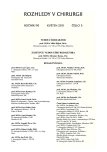Horn F., Martinka I., Fuňáková M., Šabová L., Drdulová T., Hornová J., Trnka J.: Epidemiology of Neural Tube Defects
Authors:
F. Horn; I. Martinka 1; M. Fuňáková; L. Šabová 2; T. Drdulová 3; J. Hornová 4; J. Trnka
Authors‘ workplace:
Klinika detskej chirurgie LF UKo a DFNsP, Bratislava, Slovenská republika, prednosta: doc. MUDr. J. Trnka, PhD.
; Neurologická klinika, Fakultná nemocnica Ružinov, Bratislava, Slovenská republika, prednosta: Prof. MUDr. Ľ. Lisý, DrSc.
1; II. detská klinika LF UKo a DFNsP, Bratislava, Slovenská republika, prednosta: prof. MUDr. L. Kovács, DrSc.
2; Slovenská spoločnosť pre spina bifida a/alebo hydrocefalus, o. z.
3; I. detská klinika LF UKo a DFNsP, Bratislava, Slovenská republika, prednosta: doc. MUDr. O. Červeňová, PhD.
4
Published in:
Rozhl. Chir., 2011, roč. 90, č. 5, s. 259-263.
Category:
Monothematic special - Original
Overview
Introduction:
Neural tube defects represent group of congenital diseases with relatively high incidence in population. Authors assess world and Slovak literature and statistical facts about the epidemiology of NTD and compare them with their own results of retrospective study performed in Children’s Hospital, Bratislava.
Materials and methods:
List of patients consists of 250 children (106 boys, 144 girls): X-ray images showing lumbo-sacral part of vertebral column were evaluated retrospectively (X-ray of native abdomen, urological tract or skeleton). Authors assessed presence or non-presence of spina bifida on images, without relation to age, gender or diagnosis of patients.
Results:
From the total number of 250 radiograms, 72 findings were positive (36 boys and 36 girls), 160 images were negative, 18 were unsuitable for evaluation due to low image quality. The highest diagnostic capture was from urological images – 40% of all positive findings. Incidence of spina bifida in Children’s Hospital concluded from X-ray images is quite high – 28.8%.
Conclusion:
According to the data from National Centre of Health Statistics the incidence of open caudal neural tube defects in Slovakia is under 5 per 10 000 live-born children at present time. However the occurrence of occult spina bifida is not known exactly. The high rate of spina bifida presented herein (28%) can be caused by relatively low number of evaluated radiograms. Also the fact that children were not only healthy ones and data were obtained from the western part of Slovakia as well. In conclusion we can say that after accidental finding of caudal neural tube defect consecutive diagnostics should be performed in clinical positive cases – genetics, MRI and consultation with specialists to decide for the optimal follow up of the patient.
Key words:
neural tube defects – occult spina bifida – epidemiology
Sources
1. Voth, D., Glees, P. Spina bifida – neural tube defects, Berlin, New York, de Gruyter, 1986.
2. Lindeke, L. L. Spina bifida. In: Minnesota Children with Special Health Needs [online],
http://www.health.state.mn.us/divs/fh/mcshn/bd/spina.pdf.
3. Behunová, J., Podracká, Ľ. Rázštepy nervovej trubice – súčasné pohľady na etiopatogenézu a možnosti prevencie kyselinou listovou. Čes.-slov. Pediat., roč. 63, č. 1, 2008, s. 38–46.
4. Národné centrum zdravotníckych informácií, online:
http://www.nczisk.sk/buxus/generate_page.php?page_id=473.
5. Svatý, J. Vývojové poruchy. In: Svatý, J.: Diferenční diagnostika nervových nemocí v dětském věku. Praha; Avicenum, 1983, 48–50.
6. Vogel, F. S. The Central Nervous System. In: Rubin, E., Farber, J. L.: Pathology. Philadelphia; J. B. Lippincott Company, 1994, 1379–1380.
7. Martinka, I., Horn, F., Fuňáková, M., Trnka, J., Siman, J., Haviar, D. Výskyt spina bifida u detí. Pediatria, roč. 2, č. 6 (2007), s. 329–332.
8. Anonymous. Spina bifida overview. In: eMedicineHealth [online]: http://www.emedicinehealth.com/spina_bifida/article_em.htm#Spina%20Bifida%20Overview.
9. Anonymous. Spina bifida. In: The Federal Government Source for Women’s Health Information [online], 08/2005: http://www.4woman.gov/wwd/index.htm.
10. Anonymous. What is spina bifida? In: The Association for Spina Bifida and Hydrocephalus [online]: http://www.asbah.org/UserFiles/InfSheet_1-SB.pdf.
11. Fidas, A., MacDonald, H. L., Elton, R. A., Wild, S. R., Chisholm, G. D., Scott, R. Prevalence and patterns of spina bifida occulta in 2707 normal adults. Clin. Radiol., 1987; 38(5): 537–542.
12. Kumar, P., Aneja, S., Kumar, R., Taluja, V. Spina bifida occulta in functional enuresis. Indian J. Pediatr., 2005; 72(3): 223–225.
13. Buckup, K. Neuromuskuläre Erkrankungen. In: Buckup, K.: Kinderorthopädie. Stuttgart, New York; Georg Thieme Verlag, 1987, 273–275.
14. Verity, C., Firth, H., French-Constant, C. Congenital abnormalities of the central nervous system. In: Journal of Neurol. Neurosurg. Psychiatry, 2003; 74 (3).
15. Brozmanová, M. Malformationes cerebri, medullae spinalis, cranii et vasorum cerebri. In: Buchanec, J., a kolektív: Repetitórium pediatra. Martin; Osveta, 1994, 665–667.
16. Horn, F. Spina bifida Kaudálne defekty neurálnej rúry. Prešov; Vydavateľstvo Michala Vaška, 2005.
17. Pekarovič, E. Rázštepové myelodysplázie lumbosakrálnej lokalizácie. Bratislava; Vydavateľstvo SAV, 1963.
18. Makai, F. Ochorenia krku a chrbtice. In: Ohrádka, B., a kolektív: Špeciálna chirurgia 2. Bratislava; Univerzita Komenského Bratislava, 2002, 56–57.
19. Šašinka, M., Kluka, V. Choroby chrbtice. In: Šašinka, M., Šagát, T.: Pediatria. Košice; Satus, 1998, 655–656.
20. Vojtaššák, J. Deformity chrbtice. In: Vojtaššák, J.: Ortopédia. Bratislava; SAP, 2000, 420–421.
21. Kunc, Z. Rozštěpy páteře a míchy. Dysrafie. In: Kolektiv autorů: Lékařské repetitorium Svazek 2. M-Z. Praha; Avicenum, 1982, 1626–1628.
22. Spall, C. A., Toop, N. J. Blue Bridge Lane & Fishergate House, York. Report on excavations: July 2000 to July 2002. In: Archaeological Planning Consultancy [online], 2005, http://www.archaeologicalplanningconsultancy.co.uk/mono/001/rep_bone_hum3b.html
23. Omaník, P., Cingel, V., Babala, J., Béder, I. Laparoscopy in the management of invagination in pediatric patients. Rozhl. Chir., 2010; 89 (7); 406–410.
24. Siman, J., Payer, J., Brozman, M., Tanuška, D., Pevalová, L., Mack, M., Babala, J., Jursová, M., Cingel, V., Duchaj. Separation of Siames twins in Bratislava. Bratisl. lek. listy., 2004; 105(2); 37–44.
Labels
Surgery Orthopaedics Trauma surgeryArticle was published in
Perspectives in Surgery

2011 Issue 5
Most read in this issue
- Šmíd D., Novák P., Liška V., Třeška V.: Pilonidal Sinus – Surgical Management at Our Surgical Clinic
- Ňaršanská A., Třeška V., Mírka H., Mukenšnabl P., Chlumská A.: Caroli Disease – Dilatation of Intrahepatic Bile Ducts
- Hrabálek L., Starý M., Rosík S., Wanek T.: Surgery for Symptomatic Vertebral Hemangiomas
- Šafránek J., Špidlen V., Vodička J.: Mediastinal Cysts, Surgical Management
